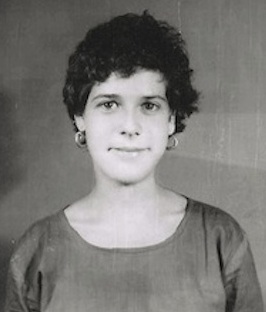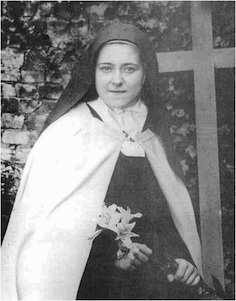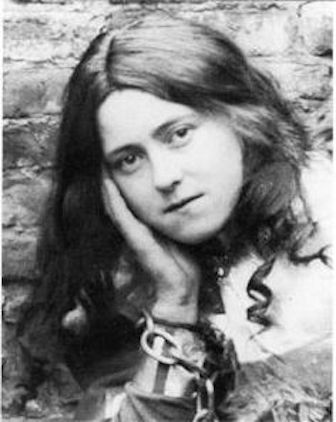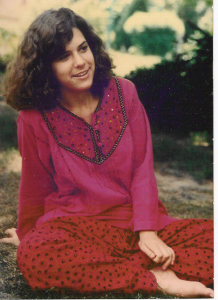Posts Tagged ‘Ammachi’
Jessica R., Saint Teresa of Lisieux, and the Rose Petal “Miracle”
“There are only two ways to live your life.
One is as though nothing is a miracle.
The other is as though everything is a miracle.”
~ Albert Einstein
“I no longer have any great desires,
beyond that of loving ’til I die of love.”
~ Saint Teresa of Lisieux
“After my death I will let fall a shower of roses…..
I will spend my Heaven in doing good upon earth.”
~ Saint Teresa of Lisieux

Jessica R., Saint Teresa of Lisieux, and the Rose Petal “Miracle”
On observing noteworthy phenomena which we can’t yet explain by known natural or scientific laws, we call them “miracles” and often attribute them to a Divine power. So some rare mystics and saints allegedly perform “miracles” for the good of humanity, and to foster faith in the Divine. Thus, after “miraculously” healing an official’s dying son, Jesus observed: “Unless ye see signs and wonders ye will not believe.” John 4:48
Here is a story about a noteworthy “miracle” involving my daughter Jessica and a mystery which I haven’t yet solved:
Following my traumatic 1976 divorce I did not share with Jessica and Joshua (my children who were then quite young) my intense new interest in Eastern religious philosophy. However, Jessica later independently became interested in Buddhism during a pre-college high school course in comparative religions. And she maintained her interest as she matriculated as a student at Amherst College, Massachusetts in the 1980’s.
In her 1983 application essay to Amherst, Jessica at age seventeen wrote:
“While I make no claim to being a Buddha –
a true master or enlightened being –
I have begun to understand that I must always be a seeker:
open and receptive to all new people, ideas, and things.
For although I have been extremely privileged
and have had the best possible education,
I haven’t yet and never will stop learning.
Having just recently discovered its spiritual dimensions,
I now know that a world of knowledge awaits me,
diverse and filled with surprises.
Fully aware of its vast potential and wealth,
I feel that I am ready to venture further into it,
and to explore what it has to offer.
‘I who do not know, and know that I do not know:
let me through this knowledge know.’
Idries Shah, The Way of the Sufi”
After her admittance and enrollment at Amherst, Jessica began doubting whether she was receiving there the “best possible education”. Seeking spiritual rather than secular knowledge, Jessica enrolled in and attended a brief accredited Buddhist Studies course in India sponsored by Antioch College. In 1987, after returning from India, she resumed her Amherst studies, and practiced Buddhist Vipassana meditations at a nearby Insight Meditation Society center. During a ten day silent meditation retreat there, she experienced a profoundly transformative spiritual awakening. Thereafter, her dissatisfaction with life at Amherst and her desire to go back to India gradually became so intense that she elected to leave Amherst for India, just one semester short of graduation. (Only after spending many years in India, did she return to complete her Amherst curriculum and post-graduate studies at Smith College.)
In India, Jessica initially spent time with Buddhist monks and practitioners in Bodh Gaya, a shrine where the Buddha was ‘enlightened’, and in Dharamsala, where the Dalai Lama of Tibet lived in exile with a large community of expatriated Tibetans. Then, planning to return to the US, she decided ‘out of curiosity’ to first visit a Hindu ashram in the state of Kerala, Southern India, the home of Ammachi, a renowned woman spiritual teacher. Instead of returning to finish her college curriculum, Jessica was so drawn to Ammachi and ashram life that she elected to live and remain there as a Hindu renunciate for many years. She was given by Ammachi the auspicious sanskrit name “Yogini”, wore only white attire, and contentedly lived the life of a Hindu nun.
While Jessica was living on the ashram in India, I consulted expert Vedic astrologers to interpret her chart or “karmic map”. I was told Jessica had an auspicious spiritual destiny, and that I would some day be “proud of her” spiritual achievements. Especially because of Jessica’s prior transformative meditation experience in Massachusetts, this seemed to me a credible prediction. So, I waited with interest to see what might happen with her.
In May of 1993, Ammachi was scheduled to make a world tour, including a stay at her San Francisco Bay area ashram in San Ramon, CA. And Jessica was to accompany Ammachi as part of her entourage. Jessica’s mother, Naomi, and I eagerly anticipated Jessica’s arrival in the Bay Area. While I continued to be supportive of Jessica’s life in India, Naomi was skeptical about Ammachi and strongly disapproved of Jessica’s life with her. She wanted Jessica to return home to finish her education and lead a “normal” life. Naomi was then living in a Victorian house in San Francisco, with a small raised front porch.
A day or two before Jessica’s scheduled arrival, Naomi awakened one morning with repeated thoughts of Jessica, and irrationally thereby intuited that Jessica was arriving then – early. She came downstairs from her bedroom and opened the front door, thinking that Jessica had arrived. Jessica was not there, but Naomi beheld that her entire front porch was strewn with rose petals of various colors. Since there were no nearby rose bushes, or other apparent explanation for the mysterious appearance of the rose petals, Naomi assumed that someone (probably Jessica’s “born-again Hindu” father) was playing a trick on her. Thereafter, when Jessica arrived as scheduled, Naomi reported to her the manifestation “miracle” of the rose petals.
Soon, Jessica recounted Naomi’s story to Ammachi. On hearing the story, Amachi gathered and handed to Jessica a packet of rose petals and instructed Jessica to give them to Naomi, “so that mother will remember this mother”. Jessica obliged, and on opening the packet Naomi observed that the rose petals from Ammachi were the same colors as those which mysteriously had appeared strewn on her front porch. So, Jessica believed that Ammachi had manifested the rose petals on Naomi’s porch, while Naomi remained skeptical about the incident, thinking it was some trick.
When Jessica told me that Ammachi apparently had graced Naomi with rose petals from “heaven”, I began continuously wondering about that incident. I had never before heard of any such manifestation attributed to Ammachi or any saint. And I wondered why such a special blessing was bestowed on Naomi, who was not a devotee of Ammachi but, rather, one who remained skeptical of Ammachi and her teachings. Also, I wondered why Ammachi would send rose petals to Naomi, rather than giving her some other spiritual experience that might assuage her skepticism and her consequent concern for Jessica’s future.
“Coincidentally” or synchronistically, soon after the rose petal incident, I read for the first time the autobiographical memoirs of Saint Teresa of Lisieux, the patron saint of France, entitled: “The Autobiography of Saint Therese of Lisieux: The Story of a Soul.” Teresa, who became the most popular of modern saints, entered a Carmelite convent at age fifteen and died there of tuberculosis, an unknown young nun, at twenty four. She would have remained unknown to the world but for her memoirs written at the direction of her prioress (in epistolary form) and for three volumes of her letters, all published posthumously.
In reading Teresa’s memoirs I was repeatedly reminded of Jessica. That little epistolary book reminded me of Jessica’s letters – of her way of sharing in writing her feelings about spiritual and inner matters. Also, apart from such syntactical similarities, I just constantly kept thinking of Jessica while reading about Teresa. But in no way did I then connect my repeated thoughts of Jessica, with the manifestation of rose petals on Naomi’s front porch, following Naomi’s repeated thoughts of Jessica. However, that mental/intuitive connection soon happened while I was on vacation in Northern New Mexico, visiting my spiritual author and poet friend Richard Schiffman.
In July, 1993, Richard and I journeyed to a remote Benedictine monastery calIed “Christ in the Desert”, situated in a very beautiful canyon on a wild river. Previously, I had asked Richard and others if they knew of any other examples of rose petal manifestations by saints, like Ammachi’s apparent rose petal “miracle” on Naomi’s front porch. Until then, no one was able to identify for me any such alleged manifestation by Ammachi or anyone else.
Not until my visit to the book shop at Christ in the Desert, did I find what I was seeking. At the book shop I found several books about Teresa of Lisieux, and I told Richard how Teresa’s autobiography had reminded me of Jessica. Thereupon, Richard remembered that Teresa had been associated with rose petal “miracles”; that during her life she often threw rose petals; that during her last illness she had announced: “After my death I will let fall a shower of roses”; and, that rose petal manifestation “miracles” (amongst others) were posthumously attributed to her.
Apparently, those “miracles” together with the publication of Teresa’s autobiographical diaries and letters resulted in such an outpouring of public sentiment that the Vatican “fast-tracked” petitions for her beatification and canonization in a manner unprecedented in modern times. When Teresa died, she was an unknown young nun. But for her writings about her inner life and aspirations, she would have remained historically unrecognized, and she would not have inspired millions of people to her ‘little way’ of spiritual devotion.
On returning to San Francisco from New Mexico, I began reading biographical materials about Teresa, and discovered some noteworthy parallels between Teresa and Jessica. Teresa – like Jessica – was a beautiful, precocious, sensitive and charismatic child to whom people were instinctively attracted. From childhood, Teresa – like Jessica – suffered from depression and other psychological insecurity issues without any apparent cause. Teresa – like Jessica – had hypersensitive hearing. In childhood, Teresa – like Jessica – could be obstinate about her wishes. From an early age Teresa – like Jessica – often showed wisdom and judgment well beyond her years. Teresa – like Jessica – had a simple yet elegant and eloquent way of sharing in diaries and epistolary writings her feelings about spiritual and inner matters.
On the eve of entering the Carmelite convent, Teresa wrote to her sister Agnes: “I want to be saint”, an aspiration which she often reiterated thereafter. In India, after soul searching and wondering about her life’s purpose, Jessica intuited and wrote in her daily journal her answer to that question: “I want to be saint”. (It is difficult to explain from her Jewish background, Jessica’s extraordinary aspiration to be a saint. Also it was surprising to me that Jessica assiduously kept journal diaries throughout her stay in India and prior thereto, a practice not instilled by her parents.)
The biographical materials about Teresa confirmed what Richard Schiffman told me at Christ in the Desert: that throughout her life Teresa loved throwing flowers and scattering rose petals as religious offerings; that shortly before her death Teresa proclaimed, “After my death I will let fall a shower of roses.” “I will spend my Heaven in doing good upon earth.”; and that rose petal manifestations were posthumously attributed to Teresa.
Also, l learned that just after Teresa’s twenty first birthday (January 2, 1894), she abandoned the sloping handwriting style which theretofore had been imposed upon her, and began to write in the way that came naturally to her: upright. In comparing photos of Teresa’s upright handwriting with Jessica’s upright handwriting, I perceived noteworthy similarities. But most noteworthy for me was comparison of photographs of Teresa and Jessica taken at similar ages. I found great similarities in their faces, especially in the eyes. To make sure I wasn’t hallucinating, one Sunday on visiting my beloved Jewish mother, Sue, I showed her a picture of Teresa dressed in nun’s habit, and asked: “Mom does this photo remind you of anyone?” Her prompt reply was: “She looks like Jessica, especially around the eyes.”
Here are the photos of Teresa and Jessica, which I found noteworthy:
By 1995, Jessica had a change of heart about continuing her life as a Hindu nun at Ammachi’s ashram. After much soul searching, she decided that she did not want to spend the rest of her life in India as a nun; that she wanted to finish her US education, marry and have children. And so after spending many years in India – in Bodh Gaya, Dharamsala, and Kerala – Jessica returned to Massachusetts to complete her Amherst curriculum and post-graduate studies at Smith College. At Smith she met and thereafter married David Channer. Their first child, Uma, was born on January 2, 2000, the 127th anniversary of Teresa’s birth on January 2, 1873.
In researching Saint Teresa, I learned that Father Jacques Sevin, a priest who founded the Boy Scouts of France, was one of her early and exceptionally ardent and influential devotees. And I found in his photo on the Internet an unusual resemblance to Jessica’s husband, David. Here are photos of Father Sevin and David Channer which I found noteworthy:



After Jessica returned to Massachusetts, I reported her changed status – from Hindu nun to American householder – to my friend Pravin Jani, father of spiritual teacher Shri Anandi Ma, and expert Vedic astrologer and pundit who had predicted an auspicious spiritual future for Jessica. His brief comment was: “Very good. She needs that experience in this lifetime.”
What does this all mean? Why did it happen? How did it happen?
I don’t know.
Did Ammachi manifest rose petals on Naomi’s porch? If so, why?
Did Saint Teresa? If so, why?
Until now, Jessica hasn’t wanted to even hear or talk about this subject. But for me it raises significant questions not only about the rose petal manifestation mystery, but about prevailing Eastern views on “reality”, afterlife, reincarnation, and evolutionary transmigration of the soul from lifetime to lifetime.
What do you think?
Remember, your thoughts are important:
“We are what we think.
All that we are arises with our thoughts.
With our thoughts, we make the world.”
~ Buddha
© The Perennial Wisdom Foundation – “From Secular Hebrew, to Born-Again Hindu, to Uncertain Undo – An ex-lawyer’s spiritual metamorphosis from Litigation to Meditation to LOVE.”
~ by Ron Rattner
From Mata Amritanandamayi to Amma Shri Karunamayi ~ Ron’s Memoirs
“… if someone is supposed to propagate the Dharma and their behavior is harmful, it is our responsibility to criticize this with a good motivation. This is constructive criticism, and you do not need to feel uncomfortable doing it. In “The Twenty Verses on the Bodhisattvas’ Vows,” it says that there is no fault in whatever action you engage in with pure motivation. Buddhist teachers who abuse sex, power, money, alcohol, or drugs, and who, when faced with legitimate complaints from their own students, do not correct their behavior, should be criticized openly and by name. This may embarrass them and cause them to regret and stop their abusive behavior. Exposing the negative allows space for the positive side to increase. When publicizing such misconduct, it should be made clear that such teachers have disregarded the Buddha’s advice. However, when making public the ethical misconduct of a Buddhist teacher, it is only fair to mention their good qualities as well.”
~ Dalai Lama, Ethics in the Teacher-Student Relationship, 1993
“Can a guru who displays jealousy and competition toward other spiritual leaders help seekers? Such behavior shows that the personality aspects, each with its own ego, are still in control.”
~ Swami Sivananda Radha, “In The Company of The Wise”, page 190
“Do not believe in anything simply because you have heard it.
Do not believe in anything simply because it is spoken and rumored by many.
Do not believe in anything simply because it is found written in your religious books.
Do not believe in anything merely on the authority of your teachers and elders.
Do not believe in traditions because they have been handed down for many generations.
But after observation and analysis, when you find that anything agrees with reason and is conducive to the good and benefit of one and all,
then accept it and live up to it.”
~ Buddha

Shri Amma Karunamayi
Introduction.
After Guruji returned to India in 1980, I met and learned from many other teachers. Beginning in 1987, I was especially attracted to the devotional path of Amritanandamayi (Ammachi) of calling and crying to the Divine, and for seven years I attended many of her US darshans and regular programs at her San Ramon ashram. (See https://sillysutras.com/other-teachers-mata-amritanandamayi-ammachi-rons-memoirs/)
But while drawn to Ammachi’s devotional path, I continued meeting other spiritual teachers. Through my interest in Ammachi, I met Shri Vijayeshwari Devi another memorable Indian female teacher known as Amma Shri Karunamayi who like Ammachi is revered by some devotees as an avatar or embodiment of divine mother. I met Karunamayi under surprising circumstances which ended my relationship with Ammachi and sparked an important new transformative life phase of increasing reliance on inner rather than outer authority. (see e.g. my essay “I’ve Found A Faith-Based Life”)
Learning of Amma Shri Karunamayi.
In 1995, my trusted friend Richard Schiffman – a talented spiritual poet, author and mainstream journalist – who I had met at an Ammachi program in New Mexico after he had lived many years in India – told me by phone that Amma Shri Karunamayi a female Indian spiritual teacher considered a Divine Mother avatar had recently visited New York and other US areas for the first time. He said that many Ammachi New York devotees had been greatly impressed by Karunamayi, and that some wanted to help her organize future US tours. From Richard’s description of Karunamayi, I felt a strong desire to see her, so I asked Richard to keep me informed of her schedule.
Synchronistically, just after Richard told me about Karunamayi, I received two letters from friends in India, telling how they had just spent a month with Karunamayi in Bangalore. They said she is “quite special [and] incredibly gentle and soft and radiates a beautiful and loving presence”, and that “many miraculous stories [are] attributed to her”. They recounted some of those stories, and reported that because Karunamayi was college educated with a focus on meditation (and not hugging) she attracted some more sophisticated devotees than the devotionally adoring people often attracted to Ammachi.
In March 1996, I again received a synchronistic phone call concerning Karunamayi, this time from another spiritual friend, who – like Richard and my friends in India – was also an Ammachi follower. Until then I was unaware that she knew of Karunamayi. So I was quite surprised when my friend asked if I could suggest some Bay Area place where Karunamayi and her entourage could stay in a few months during their first Bay Area visit. Only then did my friend disclose that she had met Karunamayi in Seattle in 1995 where she had offered to host Karunamayi’s first Bay Area visit in 1996.
Also, my friend credibly explained that Ammachi’s New York devotees had received an ‘edict’ from Ammachi – which I later confirmed – against helping or seeing Karunamayi; that she had changed her mind about hosting Karunamayi based on “personal considerations”, and because she felt disharmony with Karunamayi’s national organizers who were aggressively putting undue time pressure on her.
With compassion for my friend’s dilemma, and motivated by a sense of injustice about Ammachi’s ‘edict’ against Karunamayi, I offered to make inquiries about possible San Francisco places where Karunamayi’s entourage could reside and give public programs. But, I explained that since I was living a reclusive life in a small apartment I could not offer to personally host Karunamayi’s large entourage.
Thereupon, my friend called the national organizers for Karunamayi, “resigned” as Bay Area sponsor, and gave them my phone number as a San Francisco contact who might look for appropriate venues. Without consulting me, the Karunamayi national organizers then “conscripted” my services by distributing national flyers with my phone number as their San Francisco organizer.
Despite my displeasure with that involuntary “conscription” as a Karunamayi organizer, I did not – like my friend – tell the national organizers to ‘take me out of the loop’. My sense of compassion and justice inhibited me from leaving Karunamayi without help in the Bay Area. So I decided to help Karunamayi while seeking others who would replace me as Bay Area organizer. Thereupon my daily regime of solitary meditation and prayer and walking in Nature was significantly changed as I made and received phone calls, wrote letters and inspected possible darshan halls.
Though I never located a replacement Karunamayi sponsor, I found several friends who agreed to help. A recently widowed friend who lived alone in a very large Presidio Heights residence agreed to house Karunamayi’s entourage, and to allow morning public gatherings there. Another friend agreed to answer all telephone inquiries about Karunamayi’s schedule. And my dear friend Bina Chaudhuri – widow of Dr. Haridas Chaudhuri, with whom she had co-founded the California Institute of Integral Studies (CIIS) and the Cultural Integration Fellowship (CIF) – arranged for Karunamayi’s evening programs to be held in the lovely CIF main hall.
Meeting Karunamayi.
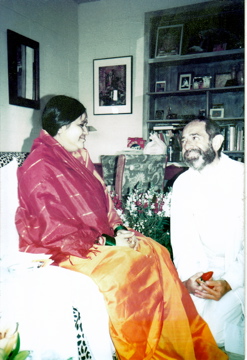
Ron with Karunamayi
As Karunamayi’s first San Francisco sponsor, I was privileged to have various private discussions with her. I learned that like Ammachi Shri Vijayeshwari Devi had no lineage or guru, but that her mother had been a devotee of Shri Ramana Maharshi, who was told by Ramana when pregnant that she would give birth to Devi [“the Mother”]. Just short of college graduation, Karunamayi had retreated to a remote forest where she spent ten years in solitary rigorous practice. Like Guruji, and consistent with her extraordinary early sadhana, Karunamayi’s emphasis was on meditation. Her presence evoked for me moods more meditative than devotional, and inspired my poetry about silence. (see e.g. https://sillysutras.com/in-silence-sweet/) Like Guruji she apparently perceived my subtle auric field. Most memorably she once told me that: “Dhyanyogi has greatly helped you in ways you can not yet know.”
She did not insist that devotees have only one guru.
Once as I was driving Karunamayi and Swami Vijashwarananda – her cousin and Telugu/English interpreter – to the beautiful Marin County Vedanta retreat center, the Swami asked: “Mother wants to know what you eat?” In response I told him: “I eat mainly raw fruits and vegetables, nuts and seeds, and rice and beans.” Whereupon the Swami interpreted my words for Karunamayi, who laughed and replied in Telugu. Then Swami said to me: ”Mother says you’ve eaten like that for many lifetimes.”
Unlike Ammachi, Karunamayi repeatedly encouraged devotees to seek company of other spiritual teachers, as well as to meditate regularly.
The “last straw” with Ammachi.

All my helper friends – like me – were Ammachi followers, but none of us felt conflict with Ammachi since Karunamayi’s San Francisco visit was scheduled for August when Ammachi would not be here. Though my sense of fairness was severely shaken by Ammachi’s New York ‘edict’ against Karunamayi, for a while I suppressed those feelings, along with my long suppressed concerns about a commercialized cult of personality around Ammachi, and the Mother Meera book burning incident. So at first that edict did not quite become “the last straw” in ending my faith in Ammachi.
That happened only after I learned of defamatory gossip and rumors about Karunamayi attributable to the Ammachi organization. Especially after I had met and was blessed by Karunamayi, and was experientially convinced of her authenticity as a spiritual master, I became deeply offended by these false and scandalous rumors, and motivated to help her as an ‘anti-defamation’ attorney.
For many years one of my daily Hindu practices from Guruji was recitation of the Hanuman Chalisa – a poetic ode to the legendary monkey-god Hanuman by poet-saint and philosopher Tulsidas. Though when I met Karunamayi my daily Chalisa practice had lapsed, Karunamayi saw the Hanuman Chalisa in my subtle field and, during a ceremony atop sacred Mount Tamalpais in Marin County, she spontaneously asked me to recite it as part of the ceremony.
Serendipitously, I had just received by mail from my friends in India a beautiful printed version of the Hanuman Chalisa. In a letter to them acknowledging that gift, I wrote:
“Slanderous rumors about Karunamayi originating at the ‘Kerala cuckoo compound’ have strongly activated my justice vasanas [propensities].” — so I wish to — “help as Her self-appointed anti-defamation lawyer. The Chalisa venerates Hanumanji as ‘the protector of saints and sages’, and after many years of recitations, I’ve assimilated some of that energy.”
So, despite my gratitude for the many devotional blessings I had received in Ammachi’s presence, after several years of growing but suppressed concerns about an ‘adulation of the incarnate’ rather than ‘adoration of the Infinite’ atmosphere around her, and about my diminished energy at her satsangs, my realization of Ammachi’s apparent jealousy and competition toward Karunamayi, Mother Meera and other teachers proved “the last straw” in my relationship with her.
Moreover, this realization traumatically brought to my consciousness the long-suppressed awareness that naively and mistakenly I had been projecting perfection onto Ammachi, rather than seeing her as a limited human being; that in adulating Ammachi I was misperceiving my own best qualities. This sudden ‘perfection projection realization’ triggered an important new transformative life phase of increasing reliance on inner rather than outer authority, which I will recount in other memoirs chapters.
(*see footnote)
Epilogue.
For many years I have been reluctant to publicly share my disaffection with Ammachi and her organization. I did not wish to discourage other devotees with different perspectives, some of whom are friends. But I now feel morally impelled to share my observations which support credibility of a recently published critical book about Ammachi, by Gail Tredwell (aka “Gayatri” or “Swamini Amritaprana”), who for twenty years was Ammachi’s revered personal attendant, and first and closest Western female devotee. Her memoir entitled “Holy Hell, A Memoir of Faith, Devotion and Pure Madness” contains many shocking but credible revelations, including reference to Ammachi’s ‘edict’ against Karunamayi (at pages 264-266).
Unable truthfully to attack the credibility of Gail’s memoir about Ammachi, the MA Centers organization has attacked Gail’s character by asserting that she is “a troubled individual” whose writings are “completely untrue and without a basis in fact or reality”, and by instigating and publishing false and defamatory rumors and on-line blog posts about her, while asserting meritless libel claims to intimidate others against commenting on or republishing Gail’s sincere perspectives.
Since I am quite convinced that Gail’s memoirs are true and sincere, I find deeply disrespectful and offensive such an ad hominem attack on her by those to whom she selflessly dedicated much of her adult life. Just as I felt impelled to assist Karunamayi against defamatory rumors, I now feel dharmically impelled to support Gail’s credibility.
Footnote.
* In further memoirs I will tell how – like some other Westerners without any guru tradition – I was naive about Ammachi and other limited or flawed Eastern teachers onto whom I mistakenly projected purported perfection and infallibility, rather than seeing them as limited humans though perhaps further evolved in spiritual awareness. And, I will recount how while faithfully revering my beloved Guruji, and while remaining grateful for blessings received from all my spiritual teachers – including Ammachi – I more and more began relying on inner rather than outer authority; and how whimsically I told friends that I had been transformed from “Born-again Hindu” to “Uncertain Undo”; from Gurubhai to ‘Guru bye bye’.
To karmically repay those few teachers I’ve forsaken in this life, in my next incarnation I may become an insurance underwriter/salesman specializing in custom coverage for spiritual teachers called: “Perfection projection protection”.
Meeting Mother Meera ~ Ron’s Memoirs
“Even avatars have to desire to be in God in every moment.
And when avatars die, they desire with all their being to be united with God. …..Look at Ramakrishna. How much he wept and prayed for the Divine Mother.”
~ Mother Meera to Andrew Harvey, “Hidden Journey”, Page 236
“’The visions that come from the Divine change you.
A real vision brings adoration of the Divine,
and in that adoration there can be no vanity. “
~ Mother Meera
“When you know that you are eternal,
you can play your true role in time.
When you know you are divine
you can become completely human.”
~ Mother Meera
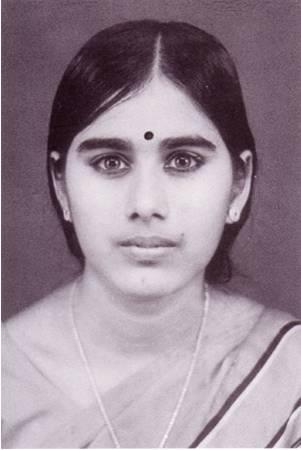
Mother Meera
Introduction.
After Guruji returned to India in 1980, I remained open to learning from other spiritual teachers. From my experience with Guruji, I had learned that ‘sitting at the feet of a master’ can be quite auspicious. Thus though Guruji encouraged initiates to follow only his Kundalini Maha Yoga path, he didn’t discourage us from seeing other teachers. Once he told my friend Joy Massa, “I’ve learned from many teachers, why shouldn’t you.” So after meeting Guruji I met and learned from many other teachers.
Beginning in 1987, I was especially attracted to the devotional path of Amritanandamayi (Ammachi) of calling and crying to the Divine, and for seven years I attended many of her US darshans and regular programs at her San Ramon ashram. (See https://sillysutras.com/other-teachers-mata-amritanandamayi-ammachi-rons-memoirs/) But while drawn to Ammachi’s devotional path, I continued meeting other spiritual teachers. One of the most memorable was Mother Meera.
Learning of Mother Meera.
In 1991 I listened on New Dimensions radio to Andrew Harvey, masterfully interviewed about his spiritual teacher, Mother Meera, by my friend Michael Toms. I learned that Mother Meera was a young Indian woman who Harvey convincingly portrayed as an alleged avatar of Divine Mother channeling Divine Light (Paramatman). So I became quite curious about Mother Meera, and read “Hidden Journey, A Spiritual Awakening”, Harvey’s book eloquently describing her. Also, at that time a trusted spiritual friend told me of his very profound inner experiences with Mother Meera, which enhanced my interest in her.
Then, in January, 1992, just after my retirement as a San Francisco litigation attorney, I journeyed to India to pay respects to my then one hundred fourteen year old beloved Guruji, Shri Dhyanyogi Madhusudandas, and thereafter to visit my daughter Jessica who – then known as “Yogini” – was living an ascetic life on Ammachi’s ashram in Kerala.
While I visited Ammachi’s ashram, my curiosity about Mother Meera was heightened. I learned that Ammachi had dramatically required that all ashram library books about Mother Meera be removed and burned. So I wondered whether Ammachi regarded Mother Meera as a false ‘avatar’? Also, whether Ammachi was competitive with Mother Meera and other spiritual teachers and, if so, why? (* See footnote)
Meeting Mother Meera.
Later in 1992, on returning from India, I decided to journey to Italy to honor Saint Francis of Assisi, with whom I long felt deep inner rapport. On learning that Mother Meera had moved from India to Germany where she gave darshans at a small town near Frankfort, I decided to fly to Europe via Frankfort, and scheduled several days in Germany before flying to Italy.
So, in July, 1992, I traveled to Thalheim, Germany, where I had three powerful evening darshans with Mother Meera unlike any others I had experienced. In an atmosphere of total silence she blessed each devotee, one by one, with a seemingly unchanging expression. As each devotee would kneel before her in complete silence, she gently held their head in her hands for a few moments. Then, as instructed, each devotee sat up as she gazed into their eyes. We were told that during this ritual Mother Meera was clearing blocks and sharing divine light.
On the first of three nights, while awaiting my turn to approach Mother Meera, I started spontaneously crying and swaying. Whereupon her companion Adilakshmi asked me to be still. (Apparently, she didn’t want me to disturb the silent meditators.) As I awaited my darshan turn, it felt to me as if a gigantic Divine Presence was channelling light through an earthly female form, wherein no one was ‘at home’. I didn’t perceive any heavenly light shows, but I did experience a tremendous and almost palpable yet extraordinarily subtle energy unlike any other I could remember. So much energy was being radiated from her eyes that at times I distinctly felt her eyelids move, even when I was seated at the back of the darshan room filled with up to 200 other people.
Especially on the third night, on gazing into Mother Meera’s eyes, I felt as if I had received an immense blessing, but I have no words to describe it. Friends in the audience reported that the energy in the entire room seemed to change while she blessed me that night.
Outwardly Mother Meera’s darshans were very different from Ammachi’s darshans. There was not a single word or sound or smile that I perceived from her during the entire visit. Unlike Ammachi, Mother Meera didn’t overtly seem to encourage devotees to fall in love with her form. Everyone – including Andrew Harvey, who was there that weekend – seemed to get the same impersonal expression and the same darshan time.
Although I was extremely grateful for the blessing of my darshans with Mother Meera, I did not feel devotionally drawn to her as had happened with Ammachi.
Back To Ammachi.
I planned my 1992 pilgrimage to Assisi to coincide with Ammachi’s world tour appearance there. So after seeing Mother Meera in Germany I traveled to Assisi where – as well as communing with beloved Saint Francis – I attended two Ammachi darshans. (See https://sillysutras.com/pilgrimage-to-assisi-communing-with-saint-francis-rons-memoirs/) Also, I was able to briefly see my daughter Jessica who was traveling in Ammachi’s entourage.
In contrast to the silent Mother Meera satsangs attended by no more than two hundred people, there were up to fifteen hundred people attending Ammachi’s Assisi programs, with a carnival-like atmosphere that troubled me, and I was told there were even bigger crowds in France. Also, I learned to my distress that in preparing the large Assisi spiritual venue for Ammachi some of her devotees had covered up pictures of other spiritual teachers which were on permanent display there.
Nonetheless, I had blissful experiences during the Ammachi darshans, where spontaneously I sang, and swayed, and cried to the Divine. During those darshans Jessica/“Yogini” was seated next to Ammachi – happily handing her flowers. Afterwards Jessica reported to me that one day Ammachi had pointed at me singing, swaying and crying, saying: “Ananda!”
Despite my mounting concerns about a growing atmosphere around Ammachi of adulation of the incarnate rather than adoration of the Infinite, I still felt much more resonant with Ammachi’s devotional path than with the austere silence of Mother Meera’s darshans. So – though gratefully I honored and respected Mother Meera – I never again attended her darshans, but continued seeing Ammachi.
Footnote.
*Ultimately, in 1995-6, I learned that Ammachi was competitive with Mother Meera and other teachers in a manner which was contrary to teachings of Guruji, Ramakrishna, and other teachers I respected. The “last straw” incident which sparked my realization of Ammachi’s competitiveness traumatically ended my faith in her as a teacher. It involved another acclaimed Indian Divine Mother avatar, Shri Amma Karunamayi and is confirmed in the recently published memoir of Gail Tredwell (aka “Gayatri” or “Swamini Amritaprana”), who for twenty years was Ammachi’s revered first and closest Western female devotee. (See “Holy Hell, A Memoir of Faith, Devotion and Pure Madness”, pp. 264-6 )
.
Other Teachers: Mata Amritanandamayi [Ammachi] ~ Ron’s Memoirs
“Crying to God for five minutes is equal to one hour of meditation.”
“The state that we attain by calling and crying to God is equal to the bliss that the yogi experiences in samadhi.”
~ Mata Amritanandamayi (Ammachi)
“The fruits of the inner man begin only with the shedding of tears.
When you reach the place of tears,
then know that your spirit has come out from the prison of this world
and has set its foot upon the path that leads towards the new age.”
~ Saint Isaac of Nineveh
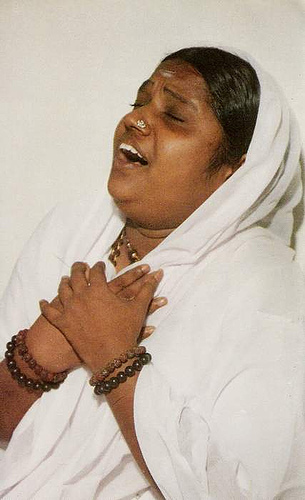
Mata Amritanandamayi
Introduction.
After receiving shaktipat from my venerable Hindu Guru, Shri Dhyanyogi Madhusudandas (Guruji), I entered a new life phase as a devotional “born-again Hindu”, and for many years thereafter I faithfully followed Guruji’s kundalini maha yoga practices. But, especially after Guruji returned to India in 1980, I synchronistically met and spent memorable time with other spiritual teachers, in addition to Guruji’s successor, Shri Anandi Ma, while always maintaining my heartfelt inner relationship with Guruji – above all other teachers.
So in writing these memoirs, as requested by Guruji, it is appropriate that I tell you about some of these other teachers.
Elsewhere I have described my 1982 India pilgrimage experiences, including my darshan with Sathya Sai Baba. I told how Sai Baba hit my head three times uttering ”Enough!” ”Enough!” ”Enough!” while I was crying uncontrollably; that I was left in a state of confusion about my pronounced devotional crying tendencies. (see https://sillysutras.com/darshan-of-sathya-sai-baba-rons-memoirs/)
My confusion about crying for God lingered until it was memorably dispelled years later during darshan of another well known spiritual personality – Mata Amritanandamayi or Ammachi – now known for hugging millions of people worldwide.
Here’s what happened.
Crying Darshan With Mata Amritanandamayi [Ammachi].
After returning from the 1982 India pilgrimage I occasionally meditated at the San Francisco Sai Baba Center. Early in 1987 Timothy Conway, a friend and former president of that center, called asking if I would host at my apartment a program about an Indian woman spiritual teacher, Amritanandamayi or Ammachi, who was then largely unknown in the US. He explained that Ammachi would soon be making her first US visit, and that a small group of her devotees from India were seeking a San Francisco venue for an advance promotional program about her; that as a favor to them he was calling me since Sai Baba Center rules precluded holding the program there.
At that time I was living in semi-seclusion and had hosted no large gatherings in the seven year period since Guruji left my apartment. Guruji was eternally enshrined in my heart, but I remained open to learning from other spiritual teachers. So I hosted at my high-rise hermitage the first San Francisco public program about Amritanandamayi, at which some of her earliest devotees shared films and stories about Ammachi’s unusual history and devotional path. One of them, Neal Rosner (Nealu), Ammachi’s first Western male disciple, had just published a memoir which I acquired and read.

Ammachi’s Earliest Close Disciples
I learned then that Ammachi had been an abused child of an Indian fisherman’s large family in a remote and primitive village in Kerala; that after constantly calling and crying for the Divine, she had manifested many extraordinary spiritual tendencies and that, ultimately she had become a noteworthy trance channel displaying Krishna and Kali energies or moods (bhavas) to the enthrallment of villagers and visitors, some of whom – with her encouragement – had begun considering her a saint or avatar.
Thereafter, on Ammachi’s arrival in the Bay area, I attended one of her first public darshans at which I unforgettably learned about her devotional path of crying for God. Unknowingly I had been following that path since my spiritual awakening. (see https://sillysutras.com/kundalini-crying-for-god-and-other-kriyas-rons-memoirs/ )
By that time I’d become a spiritual friend of pundit Pravin Jani, father of Guruji’s successor Shri Anandi Ma. Pravinji had moved with his family from Bombay to Berkeley, and together we attended an Ammachi darshan at a small house in Oakland. On our arrival, the darshan room was filled with others and there was little remaining seating room. So we sat in a far corner of the room behind the elevated throne-like chair where Amma was receiving visitors with hugs and compassionately answering their spiritual questions.
As I sat in that warm spiritual ambience I experienced a heartfelt meditative state, and tears began trickling – not ‘torrentially’ but steadily. On observing Amma hugging each person who approached her, I felt content to sit and savor that devotional environment, with tears constantly seeping from my often closed eyes. But I was not inspired to go up up for a hug.
After so sitting for some time without intending to approach Amma, one of her attending swamis came and aroused me from my meditative state, quietly saying “Mother asks that you come up for darshan.” Respectfully, I complied with that request, anticipating a quick hug and, perhaps, some blessed fruit (“prasad”). But that is not what happened.
Instead, while lovingly embracing me in her arms and then in her lap, with my tears still seeping, Ammachi gave an extended discourse on the evolutionary importance of crying for God. (Her words spoken in Malayalam were translated by a swami.) After perhaps twenty minutes she concluded her talk referring to me still in her embrace, saying: “If you can cry like him, you’ve won the spiritual sweepstakes.”
The Path of Tears.
Dramatically encouraged by Ammachi, I never again doubted the immense blessing of my spontaneous devotional longing and crying for the Divine. And with curiosity sparked by Ammachi’s discourse, I later found similar teachings from other spiritual teachers in various traditions. (see https://sillysutras.com/the-emotion-devotion-crying-for-god/ ) Especially resonant were teachings of nineteenth century Indian holy man Shri Ramakrishna Paramahamsa, with whom I had developed inner rapport after my unforgettable 1982 deja vu experience at his Dakshineswar residence place.
Ramakrisha, who had cried torrential tears for the Divine Mother, taught:
“[I]f you weep before the Lord, your tears wipe out the mind’s impurities of many births, and his grace immediately descends upon you. It is good to weep before the Lord.” – “Devotional practices are necessary only so long as tears of ecstasy do not flow at hearing the name of Hari. He needs no devotional practices whose heart is moved to tears at the mere mention of the name of Hari.”
After receiving shaktipat initiation from Guruji and the spiritual name “Rasik” – “One engrossed in devotion”, I had continuously kept yearning and often spontaneously calling and intensely weeping for the Divine. So, encouraged by Ammachi, Ramakrishna and others I was much attracted to Ammachi’s path of heartfelt singing and calling to the Divine, and was strongly motivated to see her again. And I did.
Years of tears with Ammachi.
For the next seven years after that first darshan I saw Ammachi during her bi-annual visits to the US and, in her absence, I often attended meditation programs at her nearby San Ramon ashram. Also, on my retirement, in February 1992 for several weeks I visited Ammachi’s Kerala, India ashram, since my daughter Jessica was then an ashram resident known as “Yogini”.
Though often I cried intensely for the Divine at Ammachi’s darshans, unlike most others there I usually was not motivated to receive her hugs. But in her presence I enjoyed marvelous devotional meditations, with tears, laughter, singing, and occasional spontaneous dancing to Amma’s bhajans. Thus through Ammachi I received bountiful blessings for which I am eternally grateful.
Prelude to a new life era.
At first I experienced an exceptionally powerful devotional ambience around Ammachi. And I was much moved by her soulful singing of bhajans calling to the Divine. However, my experience of devotional blessings around Ammachi and my enthusiasm for her darshans gradually diminished and eventually ended in distressing disillusionment.
After a while there seemed to be less and less pure heartfelt energy coming to me from her music and her presence. Ultimately it seemed that the music degenerated from being powerfully authentic to almost banal.
And as Ammachi attracted more and more followers, I perceived a growing cult of personality and materialistic atmosphere around her which greatly agitated and offended my pronounced egalitarian inclinations and aversions to spiritual organizations emphasizing “adulation of the incarnate” over “adoration of the Infinite”.
Also, though initially I always had felt energized by Ammachi’s darshan environment, after a while subtle energies there were more and more flowing from me, rather than to me. So, unlike my experience with Guruji, I was sometimes enervated rather than elevated after Ammachi darshans. This was especially noteworthy when I visited Ammachi’s Kerala ashram in 1992.
Moreover, I ultimately learned of private behaviors associated with or sanctioned by Ammachi which contradicted and belied her outer image and public pronouncements, and which so greatly disturbed me that I began regarding her as a flawed or false guru and not as a purported divine incarnation or avatar. (see Epilogue)
But like my traumatic marriage dissolution, the traumatic dissolution of my faith in Ammachi has proven to be a great disguised blessing which sparked an important new transformative life phase of reliance on inner rather than outer authority. (see e.g. my essay “I’ve Found A Faith-Based Life”)
Epilogue.
Because I spent seven important years at Ammachi darshans I feel obliged to write about those years in fulfillment of my obligation to Shri Dhyanyogi, my beloved guru, who requested that I write and publish my spiritual memoirs.
Until now I have been reluctant to publicly share my distressing disaffection with Ammachi and her organization. I did not wish to discourage other devotees with different perspectives, some of whom are friends. But I now feel morally impelled to tell my truth, with the intention of helping others who might learn from my experience.
Moreover, I feel morally impelled to share elsewhere my observations which support credibility of a recently published critical book about Ammachi.
Gail Tredwell (aka “Gayatri” or “Swamini Amritaprana”), who for twenty years was Ammachi’s revered first and closest Western female devotee, has just published a memoir entitled “Holy Hell, A Memoir of Faith, Devotion and Pure Madness” containing many shocking but credible revelations.
Some of Gail’s revelations are consistent with my observations and corroborate an incident which was my “last straw” with Ammachi, to be explained in another memoirs chapter. Moreover, some of her credible revelations are so shocking that I feel they should be seriously considered by those who may be contemplating relationships with Ammachi and her organization, or with other hierarchical religious or spiritual organizations.
As a long-time former litigation attorney deeply dedicated to social justice and with skills in evaluating credibility of witnesses, I read Gail’s book, initiated extended phone conversations with her, and discussed her allegations with other yet anonymous witnesses. I have found Gail to be a sincere, honest and accurate percipient witness.
Nonetheless, the MA Centers organization has attacked Gail’s character by asserting that she is “a troubled individual” whose writings are “completely untrue and without a basis in fact or reality”. Since I am quite convinced that Gail’s memoirs are absolutely true, I find deeply offensive an ad hominem attack on her by those to whom she selflessly dedicated much of her adult life, and I feel dharmically impelled to support Gail’s credibility.
